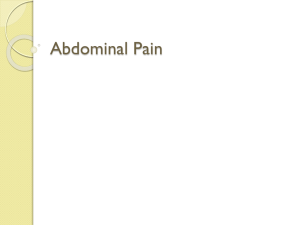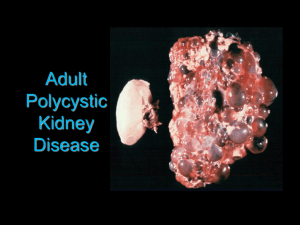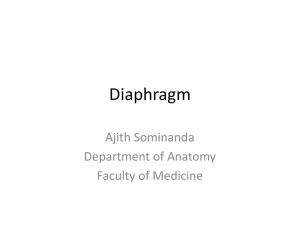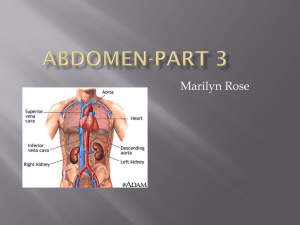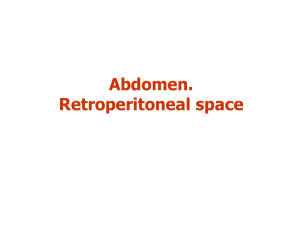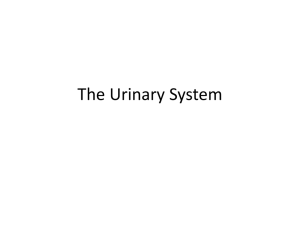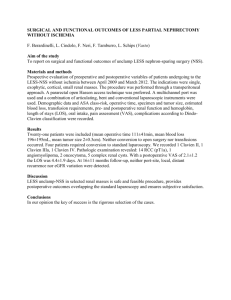Kidney, suprarenal, posterior abdominal wall
advertisement
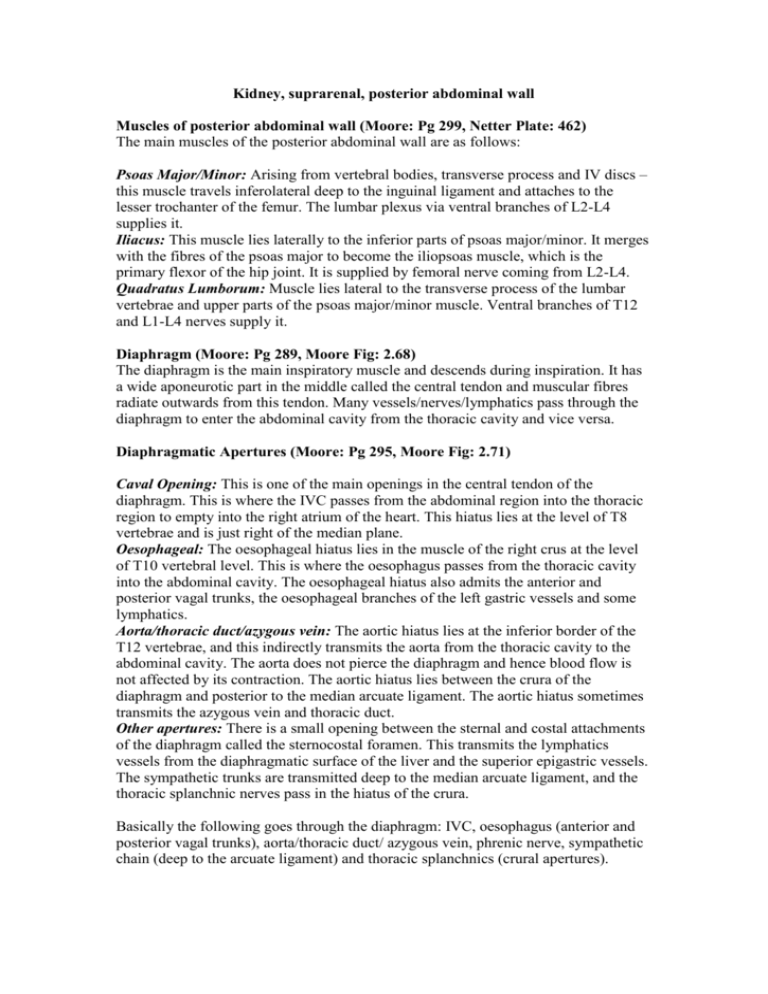
Kidney, suprarenal, posterior abdominal wall Muscles of posterior abdominal wall (Moore: Pg 299, Netter Plate: 462) The main muscles of the posterior abdominal wall are as follows: Psoas Major/Minor: Arising from vertebral bodies, transverse process and IV discs – this muscle travels inferolateral deep to the inguinal ligament and attaches to the lesser trochanter of the femur. The lumbar plexus via ventral branches of L2-L4 supplies it. Iliacus: This muscle lies laterally to the inferior parts of psoas major/minor. It merges with the fibres of the psoas major to become the iliopsoas muscle, which is the primary flexor of the hip joint. It is supplied by femoral nerve coming from L2-L4. Quadratus Lumborum: Muscle lies lateral to the transverse process of the lumbar vertebrae and upper parts of the psoas major/minor muscle. Ventral branches of T12 and L1-L4 nerves supply it. Diaphragm (Moore: Pg 289, Moore Fig: 2.68) The diaphragm is the main inspiratory muscle and descends during inspiration. It has a wide aponeurotic part in the middle called the central tendon and muscular fibres radiate outwards from this tendon. Many vessels/nerves/lymphatics pass through the diaphragm to enter the abdominal cavity from the thoracic cavity and vice versa. Diaphragmatic Apertures (Moore: Pg 295, Moore Fig: 2.71) Caval Opening: This is one of the main openings in the central tendon of the diaphragm. This is where the IVC passes from the abdominal region into the thoracic region to empty into the right atrium of the heart. This hiatus lies at the level of T8 vertebrae and is just right of the median plane. Oesophageal: The oesophageal hiatus lies in the muscle of the right crus at the level of T10 vertebral level. This is where the oesophagus passes from the thoracic cavity into the abdominal cavity. The oesophageal hiatus also admits the anterior and posterior vagal trunks, the oesophageal branches of the left gastric vessels and some lymphatics. Aorta/thoracic duct/azygous vein: The aortic hiatus lies at the inferior border of the T12 vertebrae, and this indirectly transmits the aorta from the thoracic cavity to the abdominal cavity. The aorta does not pierce the diaphragm and hence blood flow is not affected by its contraction. The aortic hiatus lies between the crura of the diaphragm and posterior to the median arcuate ligament. The aortic hiatus sometimes transmits the azygous vein and thoracic duct. Other apertures: There is a small opening between the sternal and costal attachments of the diaphragm called the sternocostal foramen. This transmits the lymphatics vessels from the diaphragmatic surface of the liver and the superior epigastric vessels. The sympathetic trunks are transmitted deep to the median arcuate ligament, and the thoracic splanchnic nerves pass in the hiatus of the crura. Basically the following goes through the diaphragm: IVC, oesophagus (anterior and posterior vagal trunks), aorta/thoracic duct/ azygous vein, phrenic nerve, sympathetic chain (deep to the arcuate ligament) and thoracic splanchnics (crural apertures). Diaphragm Attachments (Moore Pg 292) The diaphragm is a muscle extending across the border between thoracic and abdominal cavity. It is attached to the lumbar vertebral bodies, 7-12th ribs, and the xiphoid process. The median arcuate ligament unites the right and left crus of the diaphragm by passing anterior to the aortic hiatus. The diaphragm is attached medially and laterally to the to the medial and lateral arcuate ligaments, which are fascial thickenings of the psoas major and quadratus lumborum muscles. Vessels and Nerves of the diaphragm (Moore Pg 292) Vessels: The diaphragm is supplied by a range of blood vessels. Its superior surface is supplied mainly by the pericardiophrenic and musculophrenic arteries – both branches of the internal thoracic artery. The superior phrenic artery arising from the aorta also supplied this region. The inferior surface of the diaphragm are the inferior phrenic arteries which arise as the 1st branches of the abdominal aorta. The venous drainage of the superior surface is typically via the musculophrenic and pericardicophrenic veins which empty into the internal thoracic veins. The superior phrenic vein drains into the IVC. The inferior surface is drained mainly by the inferior phrenic veins. The right inferior phrenic vein usually drains directly into the IVC whereas the left inferior phrenic vein has two branches – one branch passing anterior to the oesophageal hiatus to drain into the IVC and the other posterior branch draining into the left suprarenal vein. Nerves: The nerve supply to the diaphragm is varied. The phrenic nerves arising from the ventral rami of C3-C5 spinal cord segments do the entire motor supply. This supplied the central portion of the diaphragm. The peripheral regions of the diaphragm received sensory supply from intercostal (lower 6 or 7) and subcostal nerves. Diaphragmatic hernias (Moore Pg 295) There are three main types of hernias, which can develop into diaphragmatic hernias. Congenital: This is the most common type whereby the abdominal contents are shifted into the thoracic cavity due to defects in the posterolateral aspects of the diaphragm. This can cause life-threatening consequences due to obstruction of inflation of the lung. Sliding oesophageal hernia: This is similar to a paraoesophageal hernia whereby part of the stomach slides into the thoracic cavity, causing chest pain and difficulty breathing. Paraoesophageal hernia (rolling hernias): This is more prone to complications. This is where the cardia of the stomach is displaced into the thoracic cavity and the greater curvature of the stomach rolls into the mediastinum. This causes twisting and distortion of the oesophagus. Abdominal Aorta (Netter: Plate 247) It is quite useful to know the branches of the aorta such that the foregut, midgut and hind gut derivatives can be worked out. For example: we know spleen is foregut because the splenic artery, which comes off the coeliac trunk, which we know, supplies it supplies all foregut derivatives. The abdominal aorta runs from T12 – L4. It gives off the coeliac trunk at level T12, SMA comes off at level L1, IMA comes off at level L2/L3. The abdominal aorta terminates at vertebral level L4, to become the common iliacs. These further split into internal and external iliacs supplying the pelvic viscera and lower limbs. Other minor branches of the abdominal aorta are: middle suprarenal (supplies adrenal gland), inferior phrenic arteries (supply inferior surface of diaphragm), renal arteries (supply respective kidneys) and gonadal vessels (ovarian/testicular arteries), lumbar and median sacral arteries (posterior aspect of aorta). Inferior Vena Cava (Netter Plate: 248) The inferior vena cava runs from L5-T8 (abdominal portion). At L5 level, the common iliacs join to form the IVC. At T8 it pierces the diaphragm to enter the thoracic cavity (receives hepatic veins just before this level). Some its major branches are common iliacs, renal veins (left renal vein has to travel anterior to aorta and posterior to SMA to reach the IVC), inferior phrenic, suprarenal, gonadal, lumbar and median sacral, hepatic veins (coming from liver). Lymphatics of Diaphragm (Moore Pg: 293, Fig: 2.70A) The diaphragm has nodes located on its thoracic and abdominal surface. The nodes on the abdominal surface are more concentrated compared to its counter-part. The anterior and posterior diaphragmatic nodes communicate with the parasternal, posterior mediastinal and phrenic lymph nodes. Lymphatics from the abdominal surface drain into the anterior diaphragmatic, phrenic and superior lumbar nodes. Lymphatics for the abdomen (Moore: Pg 308) There are many nodes associated with the arterial system of the abdomen. The common iliac lymph nodes receive lymph from external and internal nodes. This eventually drains into the lumbar (aortic nodes). The SM and IM nodes, along with coeliac nodes drain the foregut derivatives. Efferent vessels from these nodes drain into the intestinal trunk, forming the cisterna chyli (dilated portion of the thoracic duct) and this eventually drains into the left subclavian vein. The lumbar (aortic) nodes also receive lymph from the nodes surrounding the kidneys, adrenals and gonads. Lumbar Plexus (Moore Pg: 300 Netter Plate: 462, 463, Moore: Fig 2.74A) The lumbar plexus consists of lumbar nerves arising from L1-L4 of the ventral rami. The nerves and their courses are as follows: Obturator (L2-L4): The obturator nerve emerges on the medial border of the psoas major and travels inferiorly into the pelvis, entering them medial thigh – supplying the adductor muscles. Femoral (L2-L4): The femoral nerve emerges on the lateral border of the psoas major muscle innervating the iliacus muscle and travels inferiorly behind the inguinal ligament to enter the anterior thigh supply the muscles that contribute to hip flexion, and also supplies the extensors of the knee joint. Lumbosacral trunk (L4-L5): This never passes over the ala of the ilium descending into the pelvis, and contributes to the formation of the sacral plexus, which also involves the ventral rami of S1-S4 nerves. Ilioinguinal and Iliohypogastric (L1): These nerves emerge posterior to the medial arcuate ligament travelling infero-laterally along the surface of the quadratus lumborum muscle piercing the transverse abdominal muscles and pass through the external and internal oblique muscle supplying the skin of the suprapubic and inguinal regions. Genitofemoral (L1-L2): This nerve pierces the anterior surface of the psoas major travelling deep to the psoas fascia, and splitting into genial and femoral branches lateral to the iliac arteries. Lateral femoral cutaneous (L2-L3): Runs infero-laterally on the iliacus muscle entering the thigh posterior to the inguinal ligament and supplying skin of the anterolateral surface of thigh. Autonomic Nerves (Moore: Pg 301 Figure: 2.74B) The autonomic nerves of the abdomen can be summarised as follows: Consist of several different splanchnic nerves and these give presynaptic fibres (both sympathetic and parasympathetic fibres) to three different sources of innervation: o Nerve plexuses (aortic plexus, SM plexus, IM plexus, coeliac plexus etc) o Sympathetic ganglia (Para-vertebral chain) located on either side of abdominal aorta o Periarterial extensions of the plexuses that go to abdominal viscera, where they parasympathetic ganglia are present. Kidneys (Moore: 279, Netter Plate 311 onwards) The kidneys are completely retroperitoneal with their anterior surface covered with parietal peritoneum, and posterior surfaces adjacent to the posterior abdominal wall. The kidneys lie at vertebral levels T11/12 – L3, and the right kidney is a little lower than the left due to the large right lobe of the kidney influencing the kidney inferiorly. The hilum of the kidney is located at the level of the transpyloric plane, which runs transversely at the level where the pylorus of the stomach begins. Posterior relations (Moore: Pg 280 Netter Plate: 312) Posteriorly the kidney is associated with the 11-12th ribs and the posterior abdominal muscles such as: quadratus lumborum and psoas major, the aponeurosis of the transversus abdominis. Anterior relations (Moore: Pg 280 Netter Plate: 311) The anterior relations of each kidney differ due to different structures present in each side of the body. Think about this logically by visualising kidney in situ. Right: Liver, duodenum, loops of small intestine, suprarenal gland, right colic flexure Left: stomach, spleen, left colic flexure, suprarenal gland, some loops of small intestine, tail of pancreas. Thinking about this logically the left kidney relations differs in this way: Small intestine, suprarenal gland are the same Instead of liver, we now have stomach, tail of pancreas, and spleen Instead of right colic we have left colic flexure. Fascia of kidneys (Moore: 279 Fig: 2.61, Netter Plate: 324) Layers of fascia, to offer protection, encompass the kidney. The axial skeleton does not offer complete protection. The renal fascia is a weak septum separating the kidneys from the suprarenal glands such that they are attached to each other. The perirenal fat is extraperitoneal fat that is continuos with the hilum of the kidney, and forms a thick layer. The para-renal fat is another layer posterior to the renal fascia and this merges with the fascia associated with the transversus abdominis muscle. The kidney itself is enclosed within a thin fibrous capsule, similar to the spleen. Kidneys (Moore: 280, Netter: 313) The kidney has a medial and lateral margin, an anterior and posterior surface whilst having a superior and inferior pole. The lateral margin is convex, whilst the medial margin is concave. The medial margin is where the renal vessels and renal pelvis enter the kidney and this region is called the hilum. At the hilum, the vessels are located such that (posterior to anterior): renal pelvis, renal artery and renal vein. The renal pelvis is the dilated portion of the ureter and this splits into three major and minor calyces. The minor calyces are indented by the renal papilla, the apex of the renal pyramids (medullary pyramids). The kidney is fundamentally divided into a cortex and medulla. The cortex consists of the renal corpuscle. Between each renal pyramid is a layer of cortical tissue called renal columns. Inside the renal pyramid, there are distinct lines called medullary rays and this project upwards, sometimes into the renal cortex. Ureters (Moore: 280, Fig: 2.60, Netter Plate: 319) The ureters are muscular ducts that pass from the renal pelvis (dilated portion of ureter) to the urinary bladder, and their function is to transport urine produced in the kidneys to the bladder for excretion. The ureters travel on the anterior surface of the psoas major muscle, and anterior to the common iliac arteries (coming from abdominal aorta at L4 level) to enter the urinary bladder. The gonadal and colic vessels travel anterior to the ureter, which is an important landmark during surgery. Suprarenal gland (Moore: 285, Netter: 313) The suprarenal (adrenal) gland is divided into two main areas. The adrenal cortex derives from embryonic mesoderm and secretes corticosteroids and androgens. These are secreted in response to stress, and react to alter sodium and water retention by the kidney thus producing a change in blood volume and blood pressure. The adrenal medulla is a mass of nervous tissue among other things such as blood vessels. The chromaffin cells secrete catecholamines such as: adrenalin, noradrenaline and this activates the body’s fight or flight response. Blood supply to kidneys (Moore: 287, Netter Plate: 314, 315) The blood supply of the kidneys is all derived from the renal arteries and renal veins. The right renal artery travels posterior to the inferior vena cava to enter the hilum of the kidney. The left renal artery travels posterior to the left renal vein to enter the hilum of the kidney. The right renal vein joins the IVC after travelling a minute distance from the hilum, whereas the left renal vein travels transversely anterior to the abdominal aorta but posterior to the superior mesenteric vein (in between the two vessels) to enter the hilum of the left kidney. It is important to distinguish that renal artery gives off a small branch to the adrenal gland called the inferior suprarenal artery. From here the renal artery divides into anterior, posterior, and segmental arteries that supply the segments of the kidney’s parenchyma. It is important to note here that the kidney has little to no collateral circulation, hence an infarct of the one of these arteries will produce kidney necrosis and this could lead to kidney failure. Blood supply of suprarenal gland (Moore: 287, Netter Plate: 314, 325) The blood supply of the suprarenal gland is clearly demarked in Netter Plate: 314. There are three main arteries that supply the suprarenal gland. These are as follows: Superior suprarenal artery: this supplies the superior regions of the adrenal gland, and they come off the inferior phrenic artery, which is the first branch of the abdominal aorta. There are a number of branches that derive from here. The middle suprarenal artery: this supplies the middle region of the adrenal gland and this comes off the abdominal aorta directly just superior to the SMA. The inferior suprarenal artery: this comes off the renal arteries, and it supplies the inferior portions of the adrenal gland The venous drainage of the adrenal gland is simple. Why? Because it follows a simple pattern. The right suprarenal vein is short and empties directly into the IVC. The left suprarenal vein is longer and empties into the left renal vein often uniting with the left inferior phrenic vein before. Blood supply of ureters (Moore: 282, Netter Plate: 320) The blood supply of the ureters mainly derives from the renal arteries, gonadal arteries and abdominal aorta. The renal arteries supply the upper part of the ureter, where it lies near the kidneys, and the gonadal vessels as it passes underneath them and the abdominal aorta when it passes anterior to it. Sometimes the inferior vesical or uterine arteries, common and internal iliac arteries also contribute to the blood supply of the ureter. Innervation to kidneys, suprarenal, ureters (Moore: 282/87 Netter Plate: 322) Kidneys: The kidneys are largely supplied by parasympathetic and sympathetic nerves comprising the renal plexus. The fibres of the thoracic splanchnic nerves supply the renal plexus. Ureters: nerves coming from the renal, aortic, superior and inferior hypogastric plexuses supply the ureters. The pain afferents travel via the sympathetic fibres up to spinal cord segments T11-L1/2 (kidney and ureter). This occurs during a ureter block at one of the three constrictions of the mucosa. Suprarenal glands: These have a rich nerve supply coming from the coeliac plexus and thoracic splanchnic nerves. The nerves are mainly myelinated presynaptic fibres that derive from the lateral horn of the spinal cord, and supply the chromaffin cells of the adrenal medulla. Development of kidneys (Leave till later)
